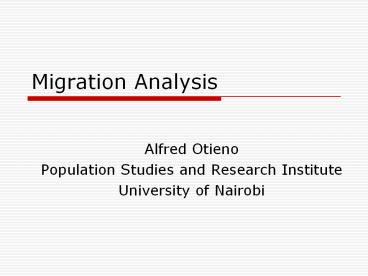Migration Analysis
Title:
Migration Analysis
Description:
Migration Analysis Alfred Otieno Population Studies and Research Institute University of Nairobi Introduction cont d In this part of the workshop we look at sources ... –
Number of Views:115
Avg rating:3.0/5.0
Title: Migration Analysis
1
Migration Analysis
- Alfred Otieno
- Population Studies and Research Institute
- University of Nairobi
2
Introduction contd
- In this part of the workshop we look at sources
and measurement of net migration, - We will cover
- Definitions and key concepts
- Sources of migration data
- Indirect and direct measurement of internal
migration for projection
3
Key Concepts and Definitions
- Migration
- Form of spatial mobility involving change of
usual residence between clearly defined
geographical units - Some change of residence are temporary or short
time and do not involve change of usual residence
e.g. visitation, work, business - Other changes in residence may permanent but
short distance
4
Types of migration
- International Movement across national
boundaries - Emigration- moving out
- Immigration coming in from another country
- Note also distinction of by permanent and
temporary, legal vs illegal - Internal movement within boundaries of a country
- Other types classification of internal migration
rural to rural, rural to urban, urban rural
and urban to urban
5
Rationale
- Often considered the least important component of
population change in some countries, - While in others migration may be as important as,
or more important than, fertility and mortality
in determining population change. - These are countries are those with substantial
circular labor migration flows (whether as
sending or host country) or longer term flows. - They may be destination countries like the U.S.
or major migrant-origin countries like Iran, or
- both sending and receiving countries, like
Thailand.
6
- For countries with substantial net international
migration, the size, composition, growth and
distribution of population is affected by that
migration. - Future population growth and characteristics are
also affected. - For sub-national projections, migration plays an
especially important role in defining future
population distribution.
7
Measuring Migration
- The utility of migration data to the demographer
depends on the question(s) to be answered, the
type of migration data available, and the
representativeness of those data.
8
Measuring International Migration
- Migration data are available from censuses (from
questions about - Birthplace,
- Residence at a previous date, (or place of
previous residence) and - Duration of residence
- Arrivals and departures data published in
statistical yearbooks, as estimates from
dedicated statistical databases and, - Population registers ( only few countries)
- Refugee statistics are available from the United
Nations High Commissioner for Refugees (UNHCR)
and other sources.
9
Types of Migration Data for Direct Estimation
Kenyan Censuses
Type Description Questions Method
Lifetime (Kenya P-18) Change of residence since birth Place of birth and place of current residence only Cross tab place of birth by place of current residence
Migration during past 12 months or another fixed reference period (Kenya P-19) Change of residence during past year Where was person living 12 months ago? Cross tab place current residence with place of residence 12 months ago
10
Types of Migration Data for Direct Estimation
Type Description Questions Methodology
Duration of residence (Kenya P-20 and P21) Least used in the last 2009 and 1999 censuses first asked in 1999 Focus on latest migration only How long lived in current residence, and Previous residence Identify non movers and movers cross tabulate for each region by age and sex movers by duration of residence
11
Types of Migration Data for Direct Estimation
Type Strengths and weaknesses
Lifetime Provides some idea of flows, but truly useful only with multiple censuses and then only by calculating differences in cohort or subpopulation size after adjusting for mortality and under enumeration. Not a good substitute for migration measured using a question on a fixed reference period.
Migration during past 12 months Excellent measure but migration may be exaggerated by recent events.
Migration during past 5 years Excellent measure providing picture of movement over past 5 years. A major weakness of this and other measures is its asymmetry for measuring international migration. Out-migrants are typically not counted well.
12
Measuring international migration (indirect
estimation)
- Net international migration also can be estimated
as a residual, comparing two foreign born
populations by age and sex from successive
censuses. Ignoring outflow of the citizen
(Kenya-born) population
13
Measuring international migration (indirect
estimation)
- Expected population by age and sex
- 10-14
- 15-19
- 75-80
- 80
Implied migrants Expected minus reported
population by age and sex 10-14 15-19 75-80 80
Provincial population by age and
sex 0-4 5-9 75-80 80
Intercensal life table survival ratios S(x5,x)/
S(x5,x)
14
Measuring international migration (indirect
estimation)
Expected population by age and
sex 10-14 15-19 75-80 80
Implied migrants Expected minus reported
population by age and sex 10-14 15-19 75-80 80
- Intercensal life table survival ratios
- S(x5,x)/ S(x5,x)
Provincial population by age and
sex 0-4 5-9 75-80 80
X
15
Measuring internal migration (indirect estimation
- Indirectly measuring internal migration
- Census survival ratio method (CSRMIG.xls) PASEX
Program - Life table survival ratio method
- Forward survival
- Reverse survival
- Composite
- Composite method
16
Census Survival Ratio Method (Schematic
Provincial population by age and
sex 0-4 5-9 75-80 80
National census survival ratios 10-14/0-4 15-19/5
-9 80/70
Expected provincial population by age and
sex 10-14 15-19 75-80 80
Implied migrants Expected minus reported
provincial population by age and
sex 10-14 15-19 75-80 80
17
Composite Survival Ratio Method (Schematic)
Provincial population by age and
sex 0-4 5-9 75-80 80
National census survival ratios 10-14/0-4 15-19/5
-9 80/70
Expected provincial population by age and
sex 10-14 15-19 75-80 80
Implied migrants Expected minus reported
provincial population by age and
sex 10-14 15-19 75-80 80
Ratio of provincial to national life table
survival ratios S(x5,x,P)/S(x5,x,N)
X
X
18
Conclusion

